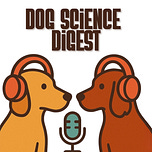In this episode, we explore the science behind the sniff—what actually happens when dogs engage with scent. Drawing from recent research on canine olfactory physiology and neuroscience, we unpack how sniffing differs from passive smelling, how dogs adjust their sniffing patterns based on context, and what happens in their brain and body as they search, discriminate, and react to smells. We also explore lateralisation, heart rate dynamics, and the cognitive and emotional consequences of the canine nose at work.
Key topics
Sniffing as a cognitive and physiological process
Neural pathways linking olfaction to emotion
Lateralised nostril use and hemispheric processing
Cardiac and cortical correlates of high-frequency sniffing
Differences between ground and air sniffing
The role of efficient sniffing in scent detection and learning
Long-read article
Study overview
This episode draws on The Art of the Sniff, a synthesis of current literature on canine olfactory mechanisms, including sniffing patterns, olfactory neuroanatomy, physiological correlates of olfaction, and the emotional significance of scent. The reviewed material spans research on dogs and rats, highlighting shared mechanisms and species-specific nuances in how scent is processed, interpreted, and acted upon. The article situates sniffing not merely as a sensory act, but as a gateway into the dog’s cognitive and affective world.
Sniffing is not just smelling: the anatomy of active olfaction
Dogs sniff at frequencies between 4–7 Hz—up to 200 times per minute. This rapid, sharp inhalation creates turbulence in the nasal cavity, enhancing the delivery of odour molecules to the olfactory epithelium (Berg et al., 2024). Approximately 12–13% of each breath is diverted via an upper flow path directly to the olfactory region, where molecules accumulate and are exposed for longer—crucial for signal detection.
Unlike humans, dogs inhale from the front and exhale to the side, and each nostril samples air separately. This bilateral sampling enables precise localisation of odours in space, a critical function during tracking or detection tasks. Passive smelling, by contrast, is a lower-resolution, unconscious process that lacks the directional, cognitive engagement of sniffing.
The sniffing brain: from olfactory bulb to emotion circuits
Sniffing activates distinct areas of the dog’s brain compared to passive odour detection. Functional imaging studies show that the piriform cortex and medial/posterior orbitofrontal gyri are active during active sniffing—even when no odour is present. In contrast, passive smelling primarily engages lateral/anterior orbitofrontal areas, suggesting sniffing is not just a sensory act but a preparatory and attentional one.
The olfactory bulb connects directly to emotional and memory-related areas including the amygdala, frontal cortex, and hippocampus. This olfactory–limbic connection explains why scent can trigger strong emotions or memories in dogs, and why familiar human scents activate the caudate nucleus, a reward-related region (Berns et al., 2015).
High-frequency sniffing: what the heart and brain reveal
Studies in rats show that high-frequency (HF) sniffing—above 6 Hz—is not just linked to odour sampling but reflects a shift in overall arousal and motivational state. During HF sniffing, heart rate increases and the motor cortex shows elevated theta/delta ratios—typically associated with attentiveness and engagement. These physiological markers occur even when the animal is stationary, suggesting that sniffing, not movement, is driving the response.
While direct canine equivalents are less studied, canine olfaction is similarly tied to heart rate and HRV (heart rate variability), particularly during emotionally charged or cognitively demanding tasks. This suggests that sniffing may serve as a marker for heightened internal engagement.
The emotional nose: scent as feeling
Dogs process emotionally charged odours differently depending on context. They tend to initiate sniffing with the right nostril, particularly for novel or arousing scents. If the odour proves non-threatening or familiar, they may switch to the left nostril. This lateralised behaviour implies hemispheric specialisation in the processing of emotional valence: right hemisphere for vigilance and arousal, left for positive or familiar signals.
Olfactory input doesn’t just inform behaviour—it modulates affect. Sniffing and scent work have been shown to increase optimistic judgement in dogs, likely through dopaminergic reward pathways. Human emotional odours also influence dogs: the scent of human fear produces longer sniff durations and more alert behaviour than happiness scents, suggesting interspecies chemosignalling plays a role in emotional contagion.
Ground vs air sniffing: strategies and structure
Dogs shift between ground sniffing and air sniffing depending on the nature of the task. Ground sniffing involves following settled odour molecules on surfaces, often ignoring distractions and using rapid, close-range sniffs. Air sniffing, by contrast, involves scanning for airborne scent plumes with the nose held aloft, often in large-area searches.
Dogs adjust their sniffing pattern as they close in on a scent source—slowing down, increasing sniff duration, and refining their localisation efforts. This suggests sniffing is dynamically responsive to environmental feedback, not simply a fixed behaviour.
Sniffing as cognitive strategy
The distinction between active sniffing and passive smelling is not merely technical—it reflects a qualitative difference in how dogs engage with their environment. Sniffing enables:
Directed attention to relevant odour cues
Encoding and recall of olfactory memories
Emotional processing of valenced stimuli
Spatial localisation and decision-making
These functions position sniffing as a cognitive act: a means of gathering, evaluating, and responding to information. Poor sniffing technique, whether due to fatigue, stress, or improper training, directly compromises olfactory performance.
Practical takeaways
Sniffing is essential for scent work: Passive smelling alone is insufficient. Active, efficient sniffing is required for successful tracking and detection.
Watch the nose: Lateralised sniffing or changes in sniff frequency can indicate emotional engagement, arousal, or novelty.
Allow dogs to sniff freely: Sniffing isn’t a distraction—it’s information gathering. Interrupting it too often may reduce emotional regulation and learning.
Use scent to influence emotion: Odours can modulate arousal, evoke memories, and support optimism. Consider this when selecting scent-based enrichment or training reinforcers.
Further reading
Fountain, J., Fernandez, E. J., McWhorter, T. J., & Hazel, S. J. (2024). The Value of Sniffing: A Scoping Review of Scent Activities for Canines. Applied Animal Behaviour Science, 106485.
Berg, P., Mappes, T., & Kujala, M. V. (2024). Olfaction in the canine cognitive and emotional processes: From behavioral and neural viewpoints to measurement possibilities. Neuroscience & Biobehavioral Reviews, 157, 105527.
Kuga, N., Nakayama, R., Shikano, Y., Nishimura, Y., Okonogi, T., Ikegaya, Y., & Sasaki, T. (2019). Sniffing behaviour‐related changes in cardiac and cortical activity in rats. The Journal of Physiology, 597(21), 5295-5306.
Siniscalchi, M., Sasso, R., Pepe, A. M., Dimatteo, S., Vallortigara, G., & Quaranta, A. (2011). Sniffing with the right nostril: lateralization of response to odour stimuli by dogs. Animal behaviour, 82(2), 399-404.
Would you like this paired with an illustrated diagram of the canine nasal airflow or brain pathway to accompany the article?













Share this post